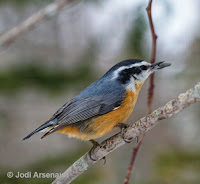RED-BREASTED NUTHATCH
RED-BREASTED NUTHATCH (Sitta canadensis) – (See images below)
DESCRIPTION: The Red-breasted Nuthatch has grey upper parts and light rufous under parts. There is a white bar above the eyes and a black bar across them. The eyes and pointed bill are black, and the legs and feet are grey. The back toe claw is relatively large to allow this species to climb down tree trunks. The tail is short. Both sexes have similar plumage. This is a small bird at about 10 cm (4 inches) long.
VOICE: https://www.xeno-canto.org/species/Sitta-canadensis – soft nasal call.
NAME: The English name ‘Nuthatch’ relates to the feeding behavior of this bird – placing seeds/nuts in crevices when they’re too large to swallow and ‘hacking’ at them. The Latin genus name ‘Sitta’ is from Greek and means ‘nuthatch’, and the Latin species name ‘canadensis’ refers to its main breeding range, Canada.
HABITAT: Prefers wooded areas with mature trees, especially conifers.
DIET: In the summer, insects and small arthropods like spiders; in the winter, seeds, particularly those of conifers. Attracted to both seed and suet feeders (see videos below).
NESTING: Both parents excavate their own nesting site in a decaying tree. About five white eggs are laid, which are incubated by the female. The chicks are fed by both parents.
DISTRIBUTION: The breeding range of this nuthatch covers most of Canada up to the tree line. There is partial migration across the USA.
Distribution map: https://en.wikipedia.org/wiki/Red-breasted_nuthatch#/media/File:Sitta_canadensis_map.svg
ON PEI: Red-breasted nuthatches are year-round residents on Prince Edward Island, and are common.
CONSERVATION: The population of this nuthatch species has slightly increased over the last few decades, and the bird is not considered at risk at the present time.
NOTES: These small birds with very short tails have a peculiar way of searching for insects in tree bark crevices: they usually start at the top and proceed down the tree, head first, holding the head high when checking around, giving them an almost acrobatic posture, with their strong feet claws (see photos below) firmly holding on to the bark behind their tiny bodies.
Interestingly, these tiny birds are bolder than black-capped chickadees at the bird feeder, and will easily displace them.
SIMILAR SPECIES: White-breasted Nuthatch – The red-breasted nuthatch is smaller than the white-breasted nuthatch, and its main call, a nasal sound although similar to that of the white-breasted nuthatch, has a lower pitch. Also the Brown Creeper – this bird is mottled brown on top, has white under parts and a longer tail. It ‘creeps’ up trunks whereas the nuthatch usually climbs down.
REFERENCES: http://www.hww.ca/en/wildlife/birds/red-breasted-nuthatch.html
https://www.audubon.org/field-guide/bird/red-breasted-nuthatch
https://www.allaboutbirds.org/guide/Red-breasted_Nuthatch/id
https://www.borealbirds.org/bird/red-breasted-nuthatch
https://www.mba-aom.ca/jsp/toc.jsp (Maritimes Breeding Bird Atlas)
DESCRIPTION: The Red-breasted Nuthatch has grey upper parts and light rufous under parts. There is a white bar above the eyes and a black bar across them. The eyes and pointed bill are black, and the legs and feet are grey. The back toe claw is relatively large to allow this species to climb down tree trunks. The tail is short. Both sexes have similar plumage. This is a small bird at about 10 cm (4 inches) long.
VOICE: https://www.xeno-canto.org/species/Sitta-canadensis – soft nasal call.
NAME: The English name ‘Nuthatch’ relates to the feeding behavior of this bird – placing seeds/nuts in crevices when they’re too large to swallow and ‘hacking’ at them. The Latin genus name ‘Sitta’ is from Greek and means ‘nuthatch’, and the Latin species name ‘canadensis’ refers to its main breeding range, Canada.
HABITAT: Prefers wooded areas with mature trees, especially conifers.
DIET: In the summer, insects and small arthropods like spiders; in the winter, seeds, particularly those of conifers. Attracted to both seed and suet feeders (see videos below).
NESTING: Both parents excavate their own nesting site in a decaying tree. About five white eggs are laid, which are incubated by the female. The chicks are fed by both parents.
DISTRIBUTION: The breeding range of this nuthatch covers most of Canada up to the tree line. There is partial migration across the USA.
Distribution map: https://en.wikipedia.org/wiki/Red-breasted_nuthatch#/media/File:Sitta_canadensis_map.svg
ON PEI: Red-breasted nuthatches are year-round residents on Prince Edward Island, and are common.
CONSERVATION: The population of this nuthatch species has slightly increased over the last few decades, and the bird is not considered at risk at the present time.
NOTES: These small birds with very short tails have a peculiar way of searching for insects in tree bark crevices: they usually start at the top and proceed down the tree, head first, holding the head high when checking around, giving them an almost acrobatic posture, with their strong feet claws (see photos below) firmly holding on to the bark behind their tiny bodies.
Interestingly, these tiny birds are bolder than black-capped chickadees at the bird feeder, and will easily displace them.
SIMILAR SPECIES: White-breasted Nuthatch – The red-breasted nuthatch is smaller than the white-breasted nuthatch, and its main call, a nasal sound although similar to that of the white-breasted nuthatch, has a lower pitch. Also the Brown Creeper – this bird is mottled brown on top, has white under parts and a longer tail. It ‘creeps’ up trunks whereas the nuthatch usually climbs down.
REFERENCES: http://www.hww.ca/en/wildlife/birds/red-breasted-nuthatch.html
https://www.audubon.org/field-guide/bird/red-breasted-nuthatch
https://www.allaboutbirds.org/guide/Red-breasted_Nuthatch/id
https://www.borealbirds.org/bird/red-breasted-nuthatch
https://www.mba-aom.ca/jsp/toc.jsp (Maritimes Breeding Bird Atlas)
 |
| Red-breasted nuthatch, by Matt Beardsley |
 |
| Red-breasted nuthatch, by Marie Smith |
 |
| Red-breasted nuthatch, Jodi Arsenault |